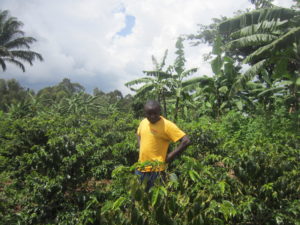Author: Michael Kimani
During a recent field trip to Uganda in June 2018, I was pleasantly surprised to learn about the efforts the country is making to put itself on top of the coffee world. Word has it that Uganda might become the next Vietnam in terms of increasing the production of coffee.
The targets: 5.4 million bags by 2020 and eventually 20 million bags by 2030. This is a very ambitious plan which came via a presidential directive that has raised the urgency of increasing production.
Operation Wealth Creation (OWC), is an intervention that H.E. the President Yoweri Kaguta Museveni launched in July 2013 to create a system that facilitates effective national socio-economic transformation with a focus on raising household incomes for poverty eradication and sustainable wealth creation.
The operation is being led by the Ugandan People Defense forces and is using veterans (retired and/or inactive) in the distribution of seedlings to the population, supporting the establishment of nurseries and offering extension services, with military-style concern for meeting delivery priorities and deadlines. The target is to supply 300 million seedlings per year for the next three years to 2020 (Beginning 2016/17), the operation has drawn in the Ugandan Coffee Development Authority, local governments and the Prime Minister’s Delivery Unit — created to bring a culture of rigor and speed in the delivery of public services.
Strategic priority
Coffee is a strategic priority for Uganda in that it supports income of subsistence farmers and, on average, generates approximately 20-30% of the country’s foreign exchange over the past years, but production has been increasing very slowly in the last 15 years to remain around 3-4 million bags. 85% of Ugandan coffee is produced by the small holder farmers with rudimentary practices, the average yield is 0.6 tons per hectare compared to 2.2 tons per hectare in Vietnam.
While Arabica was introduced at the beginning of the 1900’s, Robusta coffee is indigenous to the country, and has been a part of Ugandan life for centuries. The variety of wild Robusta coffee still growing today in Uganda’s rain forests are thought to be some of the rarest examples of naturally occurring coffee trees anywhere in the world. The coffee trees are intercropped with traditional food crops and grown in the shade of banana trees and other shade trees. In these self-sustaining conditions, coffee is left to grow naturally, flowering on average twice a year.

A Ugandan coffee farmer pauses to inspect the young, hybrid Arabica plants in this mixed coffee-banana plantation near the Rwenzori Mountains.
All necessary support
The increased global demand for coffee is good news for Uganda, it is predicted that the global demand increases at about 0.5-3% per year against an annual growth of 2% per year. It is expected that the global demand will be around 200 million bags up from the current 160 million bags. This creates an excellent opportunity for Uganda to fill in the gap coupled with an increasing demand for the quality fine Robusta Uganda is known for. Good Ugandan coffees are both unique among East African coffees and of intense character. Germany has been a strong buyer of Uganda’s Arabica crop but two years ago the outrageous jump in Java prices resulted in numerous containers appearing in the US as a Java substitute.
The president has made it clear that all the necessary support will be accorded to achieve the national coffee goals. The government plans to spend $900 million (USD) to avail quality planting materials, access to quality farm inputs, access to finance and facilitating extension services. It is now up to the Ugandan farmers and their associations to seize this opportunity to grow their incomes and play a role in meeting global demand.
Coffee vs poverty
The plain fact is, coffee is a cash crop. It is grown by 1.7 million (of which 1.17 million grow Robusta coffee) small-holder farmers in Uganda. It is 95% of the Ugandan agricultural commodities exports and 2,800,000 people rely on it for a living! Most production is Robusta, and the prices they get are low – but can be increased with better quality fine Robusta. Arabica coffee can get a better premium to the farmer, and of course quality also results in increased incentives for farmers.
CRS is already on the ground working with coffee farmers in two districts in Central and Southern Uganda. We’re working with a seasoned coffee development partner as a part of this initiative to eradicate poverty and bring Ugandan coffee to the world. Among the teething problems encountered are: low survival rate/mortality of the seedlings, the level of preparedness for the planting season is sometimes wanting, climate change is a real issue in Uganda and that there might not be much arable land left to expand area under coffee.
With all this in the works, the world should expect more coffee from Uganda in the coming years.
About the author: Michael Kimani is a program manager with the CRS Coffeelands program, covering the East and Central Africa regions. He is based in Nairobi, Kenya.


